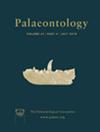对棘皮动物门神秘支系 Paracrinoidea 的初步定量评估
IF 2.3
2区 地球科学
Q1 PALEONTOLOGY
引用次数: 0
摘要
在了解现生五类棘皮动物的系统发育方面已经取得了长足进步,然而,许多古生代类群仍有待在严格的定量框架内进行研究。副棘皮动物(Paracrinoidea)是古生代棘皮动物中一个不寻常的类群,其反常的形态阻碍了将其纳入大规模的系统发育和形态学研究。本研究采用系统发育分析和形态差异相结合的方法来阐明该支系内的物种关系。研究结果表明,副脊索动物门是一个单系类群,呼吸结构、口板排列和伏喙形态对于界定副脊索动物门内的亚支系非常重要。在定量框架内研究副棘皮动物,有助于将其纳入研究古生代棘皮动物进化、生态学和生物地理学的大型项目中。本文章由计算机程序翻译,如有差异,请以英文原文为准。
Initial quantitative assessment of the enigmatic clade Paracrinoidea (Echinodermata)
Great strides have been made in understanding the phylogeny of the five extant echinoderm classes, however, many Palaeozoic groups have yet to be examined in a rigorous, quantitative framework. The aberrant morphologies of Paracrinoidea, an unusual group of Palaeozoic echinoderms, have hindered their inclusion in large‐scale phylogenetic and morphologic studies. This study uses a combined approach of phylogenetic analysis and morphological disparity to elucidate species relationships within the clade. Findings from this study suggest that Paracrinoidea is a monophyletic group and that respiratory structures, oral plate arrangement, and ambulacral morphologies are important for defining subclades within Paracrinoidea. Examination of paracrinoids in a quantitative framework, facilitates their inclusion in larger projects examining Palaeozoic echinoderm evolution, ecology and biogeography.
求助全文
通过发布文献求助,成功后即可免费获取论文全文。
去求助
来源期刊

Palaeontology
地学-古生物学
CiteScore
5.60
自引率
3.80%
发文量
43
审稿时长
6 months
期刊介绍:
Palaeontology publishes a wide variety of papers on palaeontological topics covering:
palaeozoology
palaeobotany
systematic studies
palaeoecology
micropalaeontology
palaeobiogeography
functional morphology
stratigraphy
taxonomy
taphonomy
palaeoenvironmental reconstruction
palaeoclimate analysis and biomineralization studies.
 求助内容:
求助内容: 应助结果提醒方式:
应助结果提醒方式:


